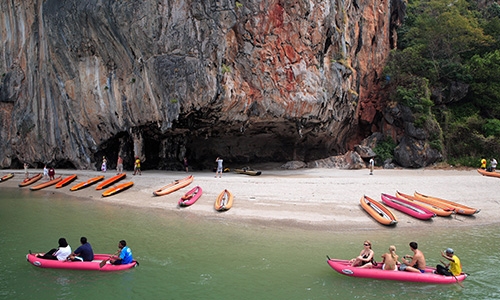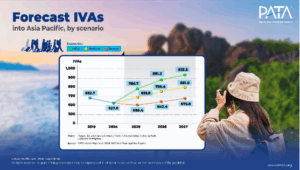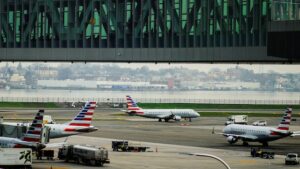International tourist arrival declines in Thailand

Three months ago, Thailand was in a state of lockdown, with martial law being announced by the Thai army and a curfew being put into place, affecting tourists and local businesses alike. And with arrivals having plunged between 20 and 40 per cent since the political crisis hit the nation, officials are now looking to aggressively step up efforts to bring the masses back in. Very much like how Egypt is adopting technological strategies and alleviating red-tape procedures, Thailand too is aiming to remain attractive to travellers, but how long will it take until it is firmly out of this rut?
According to Thailand’s Ministry of Tourism and Sports, international arrivals will fall short of targets proposed, as it is estimated that the year will close with 25.5 million trips made, not the predicted 28 million. Tourism ministry permanent secretary Suwat Sithilaw has suggested that this decline will see revenues fall by $6.3 billion, but is adamant that the 28 million target could be reached in 2015 once things settle down further.
And he could be onto something. Industry officials have been quick to clamp down on the issue, and they are looking to bring tourists back by three key methods: market analysis, visa waiving and technological solutions.
Tapping into key markets
To say that the Asian travel boom has been dominating the sector would be a huge understatement. An emerging middle class in China continues to grow its appetite for travel and with the emerging economies of India and Singapore, sector traffic is becoming increasingly concentrated in this part of the world.
It is therefore hardly surprising that Thai industry leaders want to promote the region to south-east Asian and Indian tourists; so much so that India was actually the strongest market for the country during the political crisis. In conjunction with this, the Tourism Authority of Thailand is joining forces with local operators for a trade fair in New Delhi, Kolkata, Bangalore and Ahmedabad between October 10th and 17th, to rake in high-end visitors.
And then there are those coming from south-east Asia, proved to be the biggest spenders in the region, with the ministry aiming for 8.1 million visitors from this area in 2015, a rise of 12 per cent from the 2014 target. Pichai Raktasinha, director for the ASEAN, South Asia and South Pacific market, said: “For these regions, seven offices of TAT will develop marketing strategies, in-market activities, family trips, roadshows, or whatever they can do to lure them back to Thailand.”
It is hoped that if ten million visitors come from these regional markets, they will represent 40 per cent of all arrivals and their spending potential will be limitless.
On a side note, many tourist concerns rest on travel insurance policies that are not covered under martial law or civil unrest. The tourism ministry has been keen, however, to push for special coverage known as ‘Thailand Travel Shield’ that has been set up by the ministry with four other Thai insurance firms.
Waiving visas
Of course you can tailor marketing strategies towards booming markets, but if it is not easy to travel to a destination, tourists won’t bother, and so in conjunction with all of this has been a series of visa waivers, particularly aimed at the Chinese. Considering that the Chinese accounted for 18 per cent of all arrivals in July, it is particularly concerning that numbers have been dwindling since the coup, as it is dangerous for a country whose economy depends ten per cent of its revenues on tourism.
In the first month of military rule, the number of visitors from China, Hong Kong and Japan fell by 41 per cent, 46 per cent and 25 per cent respectively, a marked difference from the three per cent slump witnessed among European travellers.
As part of new measures, a 30-day extension of stay has been given for visitors from 48 countries around the world, while Chinese guests get to enjoy a free visa. It is unclear how long this will continue, but experts believe it will last until at least the end of the year, with the hope that it will not only bolster the number of international tourists but those coming for niche-market activities, such as health, sports or volunteering. The 49 source markets represent around half of the total arrivals that came to Thailand in 2013, and they include the UK, US, Australia, Brazil, Norway and the UAE.
Tech solutions
Tourist police in the region have launched a new mobile app, Tourist Buddy, that gives travellers access to safety tips, an emergency call centre and a 24/7 hotline. If an individual is in trouble, authorities will be able to trace the call, while the person will also be able to find key locations if lost or in danger.
According to Pol.Maj.Gen.Roy Inkapairoj, the app’s developer, the main aim behind such an innovation was to make Thailand seem more attractive to dubious tourists, allowing them to revel further in the nation’s festivals and culture rather than worrying about security and safety.
It is similar to the new smartphone app, launched by the Egypt Tourism Authority, that offers travellers an index of 412 destinations and attractions in the most tourist-friendly regions.
At a time when the military government has announced that it is considering martial law, especially in tourist-heavy areas, Thailand has reached a crucial tipping point. While the coup has undoubtedly done the nation’s industry harm, others are looking at the silver lining, pointing to the clampdown of mafia-style operations at beach resorts, the cleaner streets of Bangkok and political factions being limited to their activities. And let’s not forget that six countries have lifted their advisory warnings (Cambodia, Lao, Maldives, Vietnam, Iran, and the UAE). Either way, the future still seems uncertain for a country that in recent years been on the bucket list of any backpacker; only time will tell whether these governmental efforts will translate into long-term gains.
Courtesy: wttc.org
September 9, 2014














